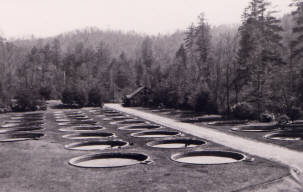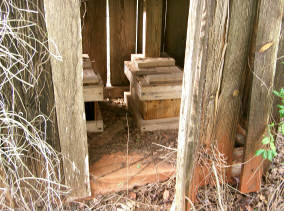Oconee County Hospital
 “Oconee County Hospital” admitted its first patient on January 31, 1939. Construction had begun the year before, with leveling and excavation work done by Works Progress Administration (WPA) workers who used shovels and wheelbarrows. The site for the hospital was chosen for its central location in Seneca at the intersection of roads leading to Walhalla, Clemson, and Westminster. This location is now the site of the Lila Doyle Nursing Care Facility. Money for the original hospital was raised by the communities that it would serve and matched by the WPA. It was not until after World War II that the name was changed to Oconee Memorial Hospital.
“Oconee County Hospital” admitted its first patient on January 31, 1939. Construction had begun the year before, with leveling and excavation work done by Works Progress Administration (WPA) workers who used shovels and wheelbarrows. The site for the hospital was chosen for its central location in Seneca at the intersection of roads leading to Walhalla, Clemson, and Westminster. This location is now the site of the Lila Doyle Nursing Care Facility. Money for the original hospital was raised by the communities that it would serve and matched by the WPA. It was not until after World War II that the name was changed to Oconee Memorial Hospital.
Fish Hatchery

Construction of the fish hatchery began in the mid-1930s. The stone hatchery building, the wood-frame garage/workshop, and the hatchery quarters were all built by the Works Progess Administration (WPA) and the Civilian Conservation Corps (CCC). Originally, the rearing tanks were small circular pools which were replaced with the present raceways during the 1950s and 1960s.
The hatchery was initially operated by the Bureau of Sport Fisheries, Department of Commerce and later, the U.S. Fish and Wildlife Service, Department of the Interior. In January of 1996, operation of the hatchery was transferred to the South Carolina Department of Natural Resources.
The Walhalla State Fish Hatchery is one of seven hatcheries in the state and is the only one involved in the culture of trout. When the trout reach a certain size, they are stocked wherever suitable habitat occurs within South Carolina.
Oconee County Health Department
The Oconee County Health Department began on April 1, 1928 in two rooms of the rock building behind the courthouse. Reported for that year were: 719 births and 388 deaths. Ten years later, reports showed 740 births and 309 deaths. Some problems faced by these early healthworkers included tuberculosis, infant mortality, pellagra, typhoid and malaria.
Prior to World War II, the nearest X-ray machine was in Anderson. However, the Mobile X-ray unit of the State Board of Health visited the Oconee County Health Department for two days every eighteen months.
In 1939, blood test clinics testing for syphilis were held in the Seneca City Hall Courtroom. Treatment followed in the basement hallway of City Hall between the coal bins, the town jail and the rest rooms. The treatment room was a broom closet, large enough for only two. Clinics were subsequently started in Westminster and Clemson.
Midwife training was also characteristic of the early Health Department. In 1938, the county was equipped with 25 to 30 midwives, at least one of which was male. Prenatal clinics and school physicals were also provided by the Department.

During the late 1930s, the Health Department provided physical examination to prospective CCC men and NYA women, who were chosen by the Department of Public Welfare. Further cooperations between the two departments was portrayed with the WPA installing sanitary toilets in rural areas of the county. A “one holer” would cost $30.

